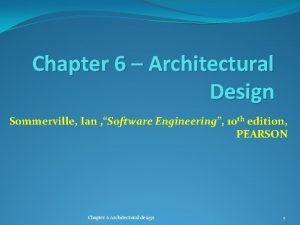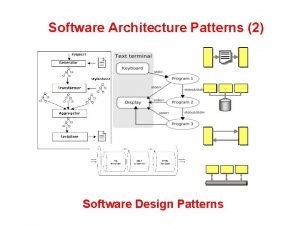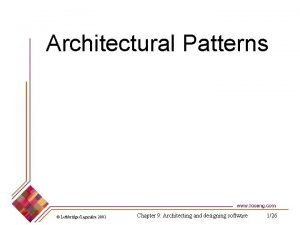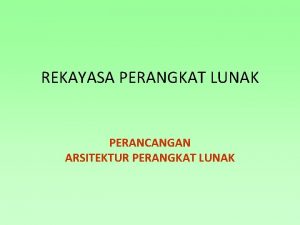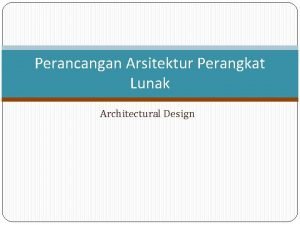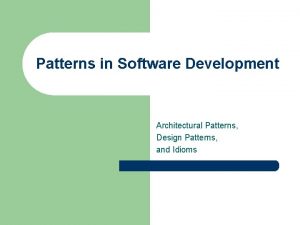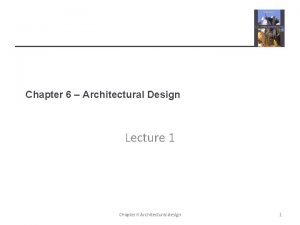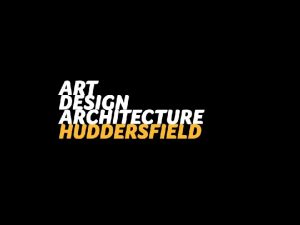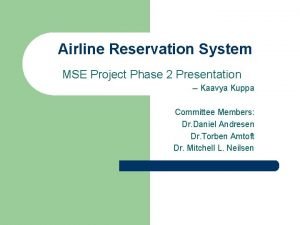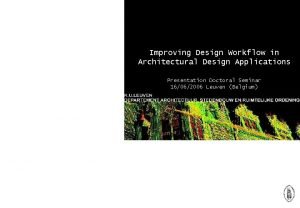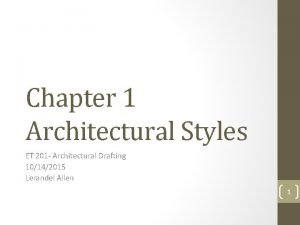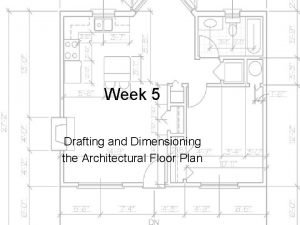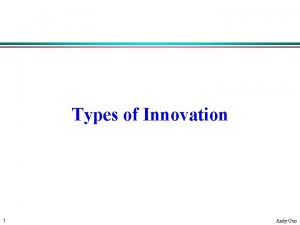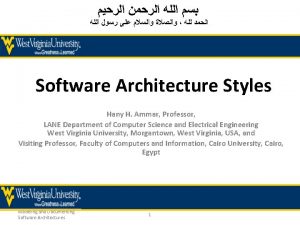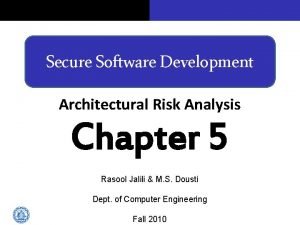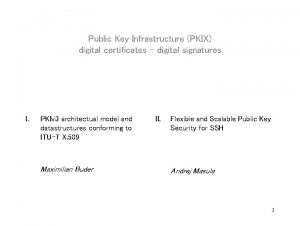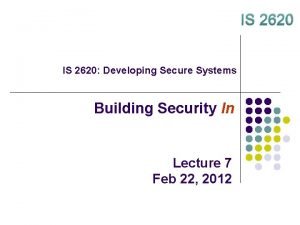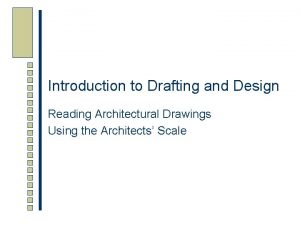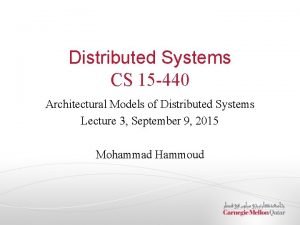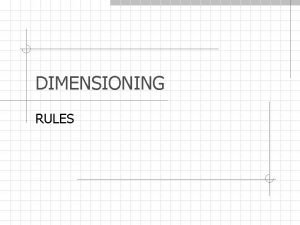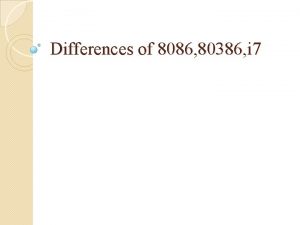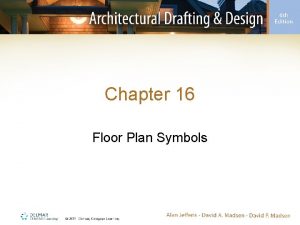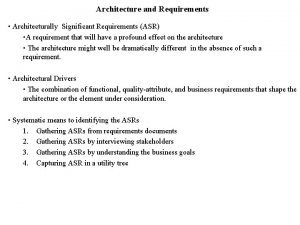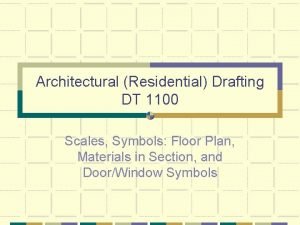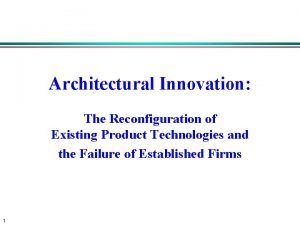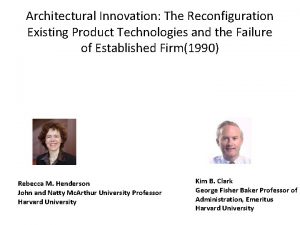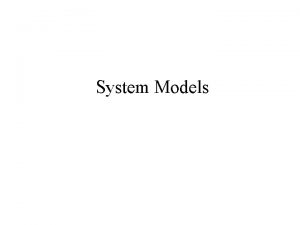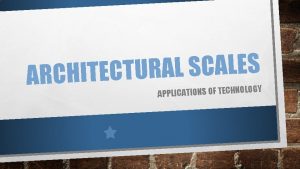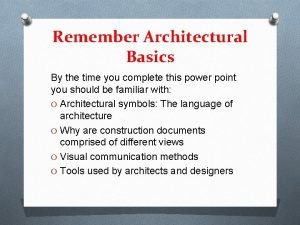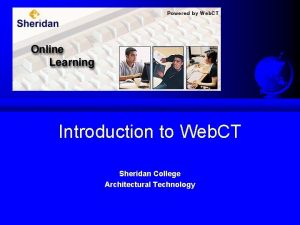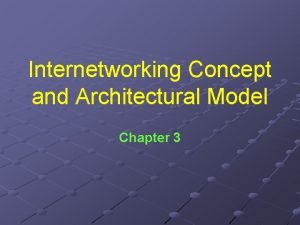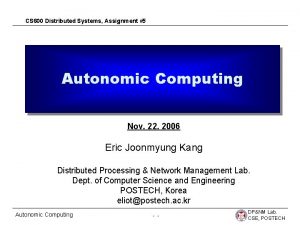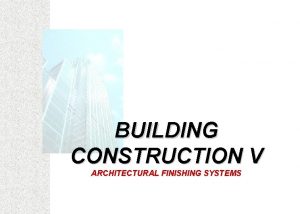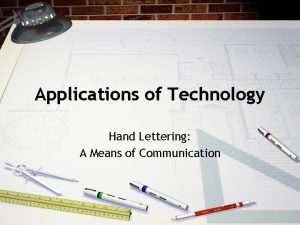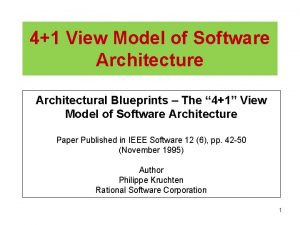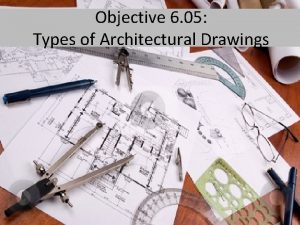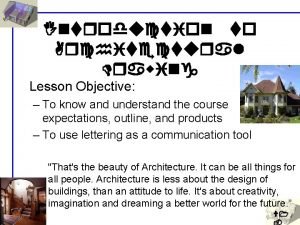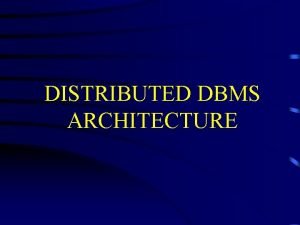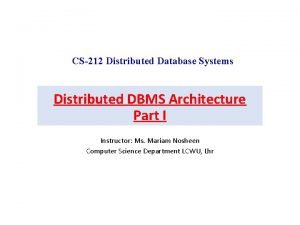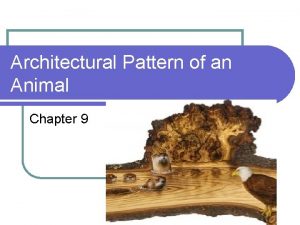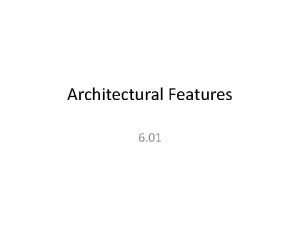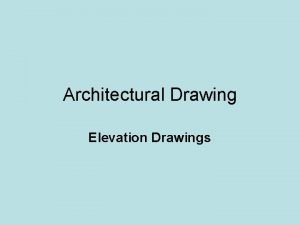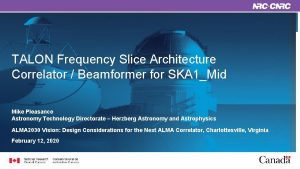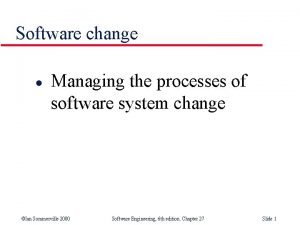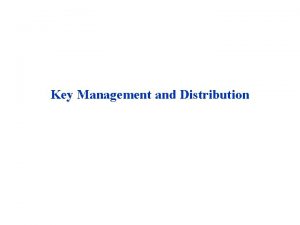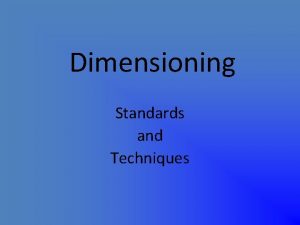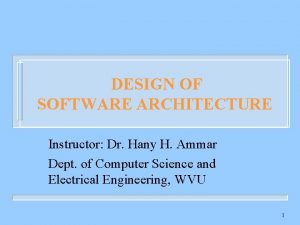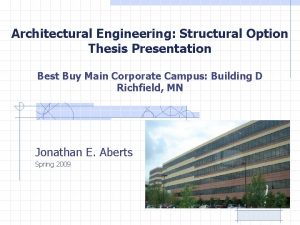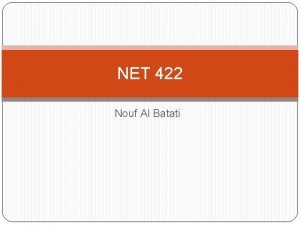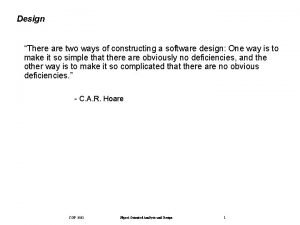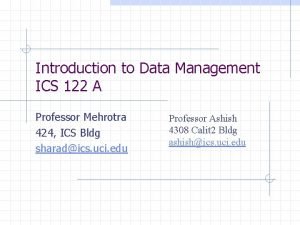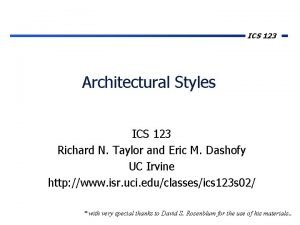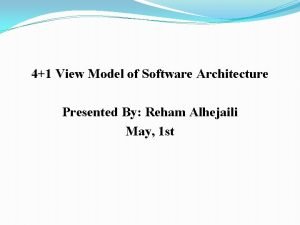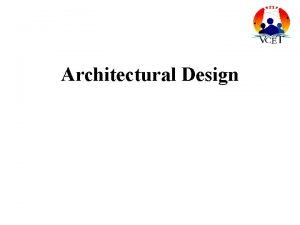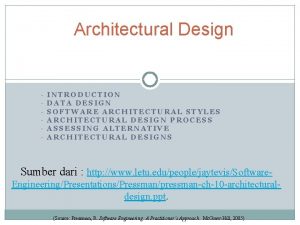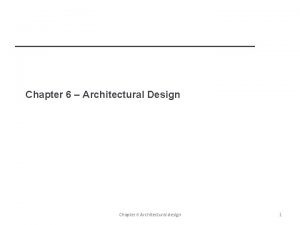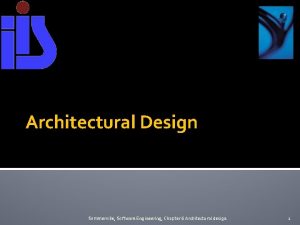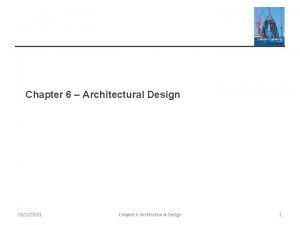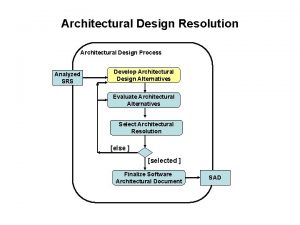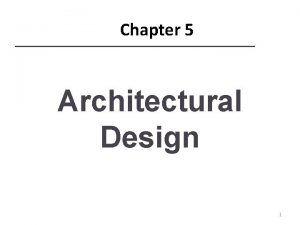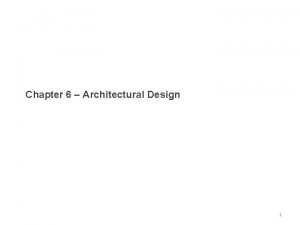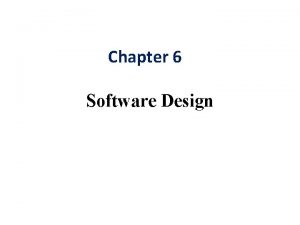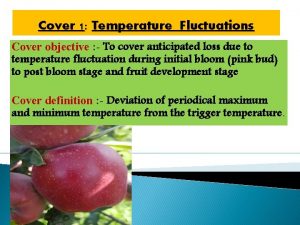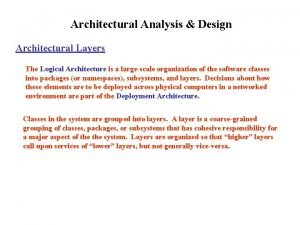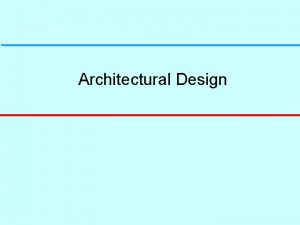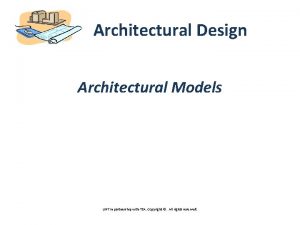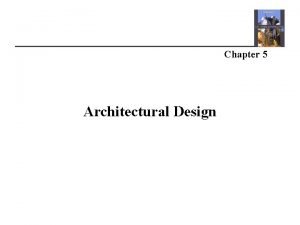Chapter 5 Software Design This will cover architectural



















































































- Slides: 83

Chapter 5 Software Design This will cover architectural design and application architectures, which is mainly Chapters 11 and 13 of Ian Sommerville’s Software Engineering.

Architectural Design Ian Sommerville, Software Engineering, Chapter 11

Objectives n n To introduce architectural design and to discuss its importance To explain the architectural design decisions that have to be made To introduce three complementary architectural styles covering organisation, decomposition and control To discuss reference architectures used to communicate and compare architectures

Topics covered n n n Architectural design decisions System organisation Decomposition styles Control styles Reference architectures

Software architecture n n The design process for identifying the subsystems making up a system and the framework for sub-system control and communication is architectural design. The output of this design process is a description of the software architecture.

Architectural design n n An early stage of the system design process. Represents the link between specification and design processes. Often carried out in parallel with some specification activities. It involves identifying major system components and their communications.

Advantages of explicit architecture n Stakeholder communication q n System analysis q n Architecture may be used as a focus of discussion by system stakeholders. Analysis of whether a system can meet its nonfunctional requirements. Large-scale reuse q The architecture may be reusable across a range of systems.

Architecture and system characteristics n n n Performance q Localise critical operations and minimise communications. Use large rather than fine-grain components. Security q Use a layered architecture with critical assets in the inner layers. Safety q Localise safety-critical features in a small number of sub-systems. Availability q Include redundant components and mechanisms for fault tolerance. Maintainability q Use fine-grain, replaceable components.

Architectural conflicts n n n Using large-grain components improves performance but reduces maintainability. Introducing redundant data improves availability but makes security more difficult. Localising safety-related features usually means more communication so degraded performance.

System structuring n n n Concerned with decomposing the system into interacting sub-systems. The architectural design is normally expressed as a block diagram presenting an overview of the system structure. More specific models showing how subsystems share data, are distributed and interface with each other may also be developed.

Packing robot control system

Box and line diagrams n n Very abstract - they do not show the nature of component relationships nor the externally visible properties of the sub-systems. However, useful for communication with stakeholders and for project planning.

Architectural design decisions n n Architectural design is a creative process so the process differs depending on the type of system being developed. However, a number of common decisions span all design processes.

Architectural design decisions n n n n Is there a generic application architecture that can be used? How will the system be distributed? What architectural styles are appropriate? What approach will be used to structure the system? How will the system be decomposed into modules? What control strategy should be used? How will the architectural design be evaluated? How should the architecture be documented?

Architecture reuse n n n Systems in the same domain often have similar architectures that reflect domain concepts. Application product lines are built around a core architecture with variants that satisfy particular customer requirements. Application architectures are covered in Chapter 13 and product lines in Chapter 18.

Architectural styles n n n The architectural model of a system may conform to a generic architectural model or style. An awareness of these styles can simplify the problem of defining system architectures. However, most large systems are heterogeneous and do not follow a single architectural style.

Architectural models n n n Used to document an architectural design. Static structural model that shows the major system components. Dynamic process model that shows the process structure of the system. Interface model that defines sub-system interfaces. Relationships model such as a data-flow model that shows sub-system relationships. Distribution model that shows how sub-systems are distributed across computers.

System organisation n n Reflects the basic strategy that is used to structure a system. Three organisational styles are widely used: q q q A shared data repository style; A shared services and servers style; An abstract machine or layered style.

The repository model n Sub-systems must exchange data. This may be done in two ways: q q n Shared data is held in a central database or repository and may be accessed by all subsystems; Each sub-system maintains its own database and passes data explicitly to other sub-systems. When large amounts of data are to be shared, the repository model of sharing is most commonly used.

CASE toolset architecture

Repository model characteristics n Advantages q q n Efficient way to share large amounts of data; Sub-systems need not be concerned with how data is produced Centralised management e. g. backup, security, etc. Sharing model is published as the repository schema. Disadvantages q q Sub-systems must agree on a repository data model. Inevitably a compromise; Data evolution is difficult and expensive; No scope for specific management policies; Difficult to distribute efficiently.

Client-server model n n Distributed system model which shows how data and processing is distributed across a range of components. Set of stand-alone servers which provide specific services such as printing, data management, etc. Set of clients which call on these services. Network which allows clients to access servers.

Film and picture library

Client-server characteristics n Advantages q q q n Distribution of data is straightforward; Makes effective use of networked systems. May require cheaper hardware; Easy to add new servers or upgrade existing servers. Disadvantages q q q No shared data model so sub-systems use different data organisation. Data interchange may be inefficient; Redundant management in each server; No central register of names and services - it may be hard to find out what servers and services are available.

Abstract machine (layered) model n n Used to model the interfacing of sub-systems. Organises the system into a set of layers (or abstract machines) each of which provide a set of services. Supports the incremental development of sub -systems in different layers. When a layer interface changes, only the adjacent layer is affected. However, often artificial to structure systems in this way.

Version management system

Sub-systems and modules n n A sub-system is a system in its own right whose operation is independent of the services provided by other sub-systems. A module is a system component that provides services to other components but would not normally be considered as a separate system.

Modular decomposition n n Another structural level where sub-systems are decomposed into modules. Two modular decomposition models covered q q n An object model where the system is decomposed into interacting object; A pipeline or data-flow model where the system is decomposed into functional modules which transform inputs to outputs. If possible, decisions about concurrency should be delayed until modules are implemented.

Object models n n n Structure the system into a set of loosely coupled objects with well-defined interfaces. Object-oriented decomposition is concerned with identifying object classes, their attributes and operations. When implemented, objects are created from these classes and some control model used to coordinate object operations.

Invoice processing system

Object model advantages n n Objects are loosely coupled so their implementation can be modified without affecting other objects. The objects may reflect real-world entities. OO implementation languages are widely used. However, object interface changes may cause problems and complex entities may be hard to represent as objects.

Function-oriented pipelining n n Functional transformations process their inputs to produce outputs. May be referred to as a pipe and filter model (as in UNIX shell). Variants of this approach are very common. When transformations are sequential, this is a batch sequential model which is extensively used in data processing systems. Not really suitable for interactive systems.

Invoice processing system

Pipeline model advantages n n n Supports transformation reuse. Intuitive organisation for stakeholder communication. Easy to add new transformations. Relatively simple to implement as either a concurrent or sequential system. However, requires a common format for data transfer along the pipeline and difficult to support event-based interaction.

Control styles n n Are concerned with the control flow between sub-systems. Distinct from the system decomposition model. Centralised control q n One sub-system has overall responsibility for control and starts and stops other sub-systems. Event-based control q Each sub-system can respond to externally generated events from other sub-systems or the system’s environment.

Centralised control n n A control sub-system takes responsibility for managing the execution of other sub-systems. Call-return model q n Top-down subroutine model where control starts at the top of a subroutine hierarchy and moves downwards. Applicable to sequential systems. Manager model q Applicable to concurrent systems. One system component controls the stopping, starting and coordination of other system processes. Can be implemented in sequential systems as a case statement.

Call-return model

Real-time system control

Event-driven systems n n Driven by externally generated events where the timing of the event is outwith the control of the subsystems which process the event. Two principal event-driven models q q n Broadcast models. An event is broadcast to all sub-systems. Any sub-system which can handle the event may do so; Interrupt-driven models. Used in real-time systems where interrupts are detected by an interrupt handler and passed to some other component for processing. Other event driven models include spreadsheets and production systems.

Broadcast model n n Effective in integrating sub-systems on different computers in a network. Sub-systems register an interest in specific events. When these occur, control is transferred to the subsystem which can handle the event. Control policy is not embedded in the event and message handler. Sub-systems decide on events of interest to them. However, sub-systems don’t know if or when an event will be handled.

Selective broadcasting

Interrupt-driven systems n n Used in real-time systems where fast response to an event is essential. There are known interrupt types with a handler defined for each type. Each type is associated with a memory location and a hardware switch causes transfer to its handler. Allows fast response but complex to program and difficult to validate.

Interrupt-driven control

Reference architectures n n Architectural models may be specific to some application domain. Two types of domain-specific model q q n Generic models which are abstractions from a number of real systems and which encapsulate the principal characteristics of these systems. Covered in Chapter 13. Reference models which are more abstract, idealised model. Provide a means of information about that class of system and of comparing different architectures. Generic models are usually bottom-up models; Reference models are top-down models.

Reference architectures n n n Reference models are derived from a study of the application domain rather than from existing systems. May be used as a basis for system implementation or to compare different systems. It acts as a standard against which systems can be evaluated. OSI model is a layered model for communication systems.

OSI reference model

Case reference model n Data repository services q n Data integration services q n Definition and enaction of process models. Messaging services q n Managing groups of entities. Task management services q n Storage and management of data items. Tool-tool and tool-environment communication. User interface services q User interface development.

The ECMA reference model

Application Architectures Ian Sommerville, Software Engineering, Chapter 13

Objectives n n To explain the organisation of two fundamental models of business systems batch processing and transaction processing systems To describe the abstract architecture of resource management systems To explain how generic editors are event processing systems To describe the structure of language processing systems

Topics covered n n Data processing systems Transaction processing systems Event processing systems Language processing systems

Generic application architectures n n n Application systems are designed to meet an organisational need. As businesses have much in common, their application systems also tend to have a common architecture that reflects the application requirements. A generic architecture is configured and adapted to create a system that meets specific requirements.

Use of application architectures n n n As a starting point for architectural design. As a design checklist. As a way of organising the work of the development team. As a means of assessing components for reuse. As a vocabulary for talking about application types.

Application types n Data processing applications q n Transaction processing applications q n Data-centred applications that process user requests and update information in a system database. Event processing systems q n Data driven applications that process data in batches without explicit user intervention during the processing. Applications where system actions depend on interpreting events from the system’s environment. Language processing systems q Applications where the users’ intentions are specified in a formal language that is processed and interpreted by the system.

Application type examples n Data processing systems q q n Transaction processing systems q q n E-commerce systems; Reservation systems. Event processing systems q q n Billing systems; Payroll systems. Word processors; Real-time systems. Language processing systems q q Compilers; Command interpreters.

Data processing systems n n Systems that are data-centred where the databases used are usually orders of magnitude larger than the software itself. Data is input and output in batches q q n Input: A set of customer numbers and associated readings of an electricity meter; Output: A corresponding set of bills, one for each customer number. Data processing systems usually have an input-process-output structure.

Input-process-output model

Input-process-output n n n The input component reads data from a file or database, checks its validity and queues the valid data for processing. The process component takes a transaction from the queue (input), performs computations and creates a new record with the results of the computation. The output component reads these records, formats them accordingly and writes them to the database or sends them to a printer.

Data-flow diagrams n n Show data is processed as it moves through a system. Transformations are represented as roundedged rectangles, data-flows as arrows between them and files/data stores as rectangles.

Salary payment DFD

Transaction processing systems n n Process user requests for information from a database or requests to update the database. From a user perspective a transaction is: q q n Any coherent sequence of operations that satisfies a goal; For example - find the times of flights from London to Paris. Users make asynchronous requests for service which are then processed by a transaction manager.

Transaction processing

ATM system organisation

Transaction processing middleware n n Transaction management middleware or teleprocessing monitors handle communications with different terminal types (e. g. ATMs and counter terminals), serialises data and sends it for processing. Query processing takes place in the system database and results are sent back through the transaction manager to the user’s terminal.

Transaction management

Information systems architecture n n Information systems have a generic architecture that can be organised as a layered architecture. Layers include: q q The user interface User communications Information retrieval System database

Information system structure

LIBSYS architecture n n The library system LIBSYS is an example of an information system. User communications layer: q q q n LIBSYS login component; Form and query manager; Print manager; Information retrieval layer q q Distributed search; Document retrieval; Rights manager; Accounting.

LIBSYS organisation

Resource allocation systems n n Systems that manage a fixed amount of some resource (football game tickets, books in a bookshop, etc. ) and allocate this to users. Examples of resource allocation systems: q q q Timetabling systems where the resource being allocated is a time period; Library systems where the resource being managed is books and other items for loan; Air traffic control systems where the resource being managed is the airspace.

Resource allocation architecture n Resource allocation systems are also layered systems that include: q q q q A resource database; A rule set describing how resources are allocated; A resource manager; A resource allocator; User authentication; Query management; Resource delivery component; User interface.

Layered resource allocation

Layered system implementation n Each layer can be implemented as a large scale component running on a separate server. This is the most commonly used architectural model for web-based systems. On a single machine, the middle layers are implemented as a separate program that communicates with the database through its API. Fine-grain components within layers can be implemented as web services.

E-commerce system architecture n n E-commerce systems are Internet-based resource management systems that accept electronic orders for goods or services. They are usually organised using a multitier architecture with application layers associated with each tier.

Event processing systems n n n These systems respond to events in the system’s environment. Their key characteristic is that event timing is unpredictable so the architecture has to be organised to handle this. Many common systems such as word processors, games, etc. are event processing systems.

Editing systems n n Real-time systems (Chapter 15) and editing systems are the most common types of event processing system. Editing system characteristics: q q q Single user systems; Must provide rapid feedback to user actions; Organised around long transactions so may include recovery facilities.

Editing system components n Editing systems are naturally object-oriented: q q q q Screen - monitors screen memory and detects events; Event - recognises events and passes them for processing; Command - executes a user command; Editor data - manages the editor data structure; Ancillary data - manages other data such as styles and preferences; File system - manages file I/O; Display - updates the screen display.

Editing system architecture

Language processing systems n n n Accept a natural or artificial language as input and generate some other representation of that language. May include an interpreter to act on the instructions in the language that is being processed. Used in situations where the easiest way to solve a problem is to describe an algorithm or describe the system data q Meta-case tools process tool descriptions, method rules, etc and generate tools.

A language processing system

Language processing components n n n Lexical analyser Symbol table Syntax analyser Syntax tree Semantic analyser Code generator

Data-flow model of a compiler

Repository model of a compiler
 Architectural design in software engineering
Architectural design in software engineering Six cardinal fields of gaze
Six cardinal fields of gaze Cover uncover test vs alternating cover test
Cover uncover test vs alternating cover test Harmonious arc
Harmonious arc Blackboard design pattern
Blackboard design pattern Architectural pattern in software engineering
Architectural pattern in software engineering Software architecture diagram
Software architecture diagram Perancangan arsitektur perangkat lunak
Perancangan arsitektur perangkat lunak Architectural patterns in software engineering
Architectural patterns in software engineering Architectural design
Architectural design Architectural design in huddersfield
Architectural design in huddersfield Architecture design objectives
Architecture design objectives Airline reservation system project ppt
Airline reservation system project ppt Architectural design workflow
Architectural design workflow Chapter 1 architectural styles
Chapter 1 architectural styles Real time software design in software engineering
Real time software design in software engineering Design principles in software engineering
Design principles in software engineering Magazine covers design
Magazine covers design Interactive science notebook cover design
Interactive science notebook cover design Web designer cover letter
Web designer cover letter Contemporary magazine design
Contemporary magazine design Floor plan dimensioning
Floor plan dimensioning Modular innovation examples
Modular innovation examples Blackboard architecture style example
Blackboard architecture style example Software architecture styles
Software architecture styles Architectural risk analysis
Architectural risk analysis Pkix architectural model
Pkix architectural model Architectural ventilation
Architectural ventilation Cigital's architectural risk analysis process
Cigital's architectural risk analysis process Conceptual and architectural framework of iot
Conceptual and architectural framework of iot Reading architectural drawings
Reading architectural drawings Architectural model of distributed system
Architectural model of distributed system Architectural dimensioning rules
Architectural dimensioning rules Compare 8086 and 80386 processor
Compare 8086 and 80386 processor Triploblasts
Triploblasts Ground plan symbols
Ground plan symbols Struts architecture
Struts architecture Asr meaning in architecture
Asr meaning in architecture Architectural symbols
Architectural symbols Architectural innovation
Architectural innovation Architectural innovation
Architectural innovation Architectural styles and patterns
Architectural styles and patterns Pantheon
Pantheon Sliding door symbol
Sliding door symbol Architectural engineering penn state
Architectural engineering penn state Fundamental model in distributed system
Fundamental model in distributed system Common architectural scales
Common architectural scales Architectural basics
Architectural basics Sheridan college architectural technology
Sheridan college architectural technology Internetworking concepts and architectural model
Internetworking concepts and architectural model Building symbols and their names
Building symbols and their names An architectural blueprint for autonomic computing
An architectural blueprint for autonomic computing Architectural finishing systems
Architectural finishing systems Characteristics of lettering
Characteristics of lettering 4+1 architectural view model
4+1 architectural view model Types of architectural drawings
Types of architectural drawings Introduction to architectural drawing
Introduction to architectural drawing 5 level schema architecture of distributed database
5 level schema architecture of distributed database Distributed dbms architecture
Distributed dbms architecture Broker pattern
Broker pattern Schizocoelom vs enterocoelom
Schizocoelom vs enterocoelom Architectural roof features
Architectural roof features Architectural drawing layout
Architectural drawing layout Architectural lettering
Architectural lettering Talon dx
Talon dx South african council for the architectural profession
South african council for the architectural profession Architectural evolution
Architectural evolution Key management and distribution
Key management and distribution Architectural evolution
Architectural evolution Dimensions
Dimensions Architectural styles
Architectural styles Beacon hill architectural commission
Beacon hill architectural commission Architectural metal coating
Architectural metal coating Architectural thesis presentation
Architectural thesis presentation Architectural scale review answer key
Architectural scale review answer key Architectural model
Architectural model Architectural style
Architectural style A gambrel is what type of architectural feature?
A gambrel is what type of architectural feature? Architectural digest n 156 ddl
Architectural digest n 156 ddl Gambrel roof interior design
Gambrel roof interior design Pipe and filter architecture advantages and disadvantages
Pipe and filter architecture advantages and disadvantages A note on style
A note on style Architectural style
Architectural style 4+1 architectural view model
4+1 architectural view model
